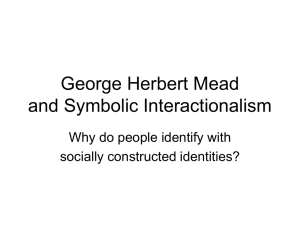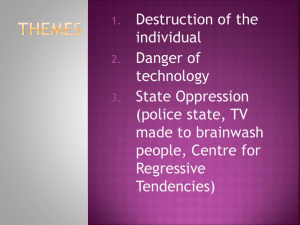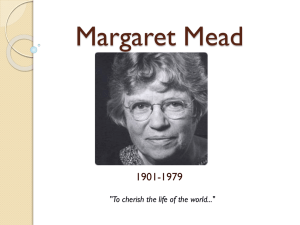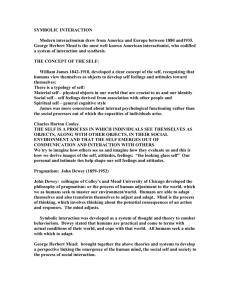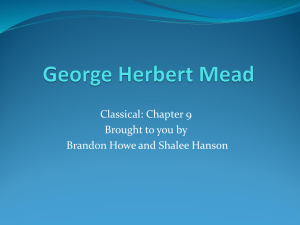Mead`s Cosmology - Valdosta State University
advertisement
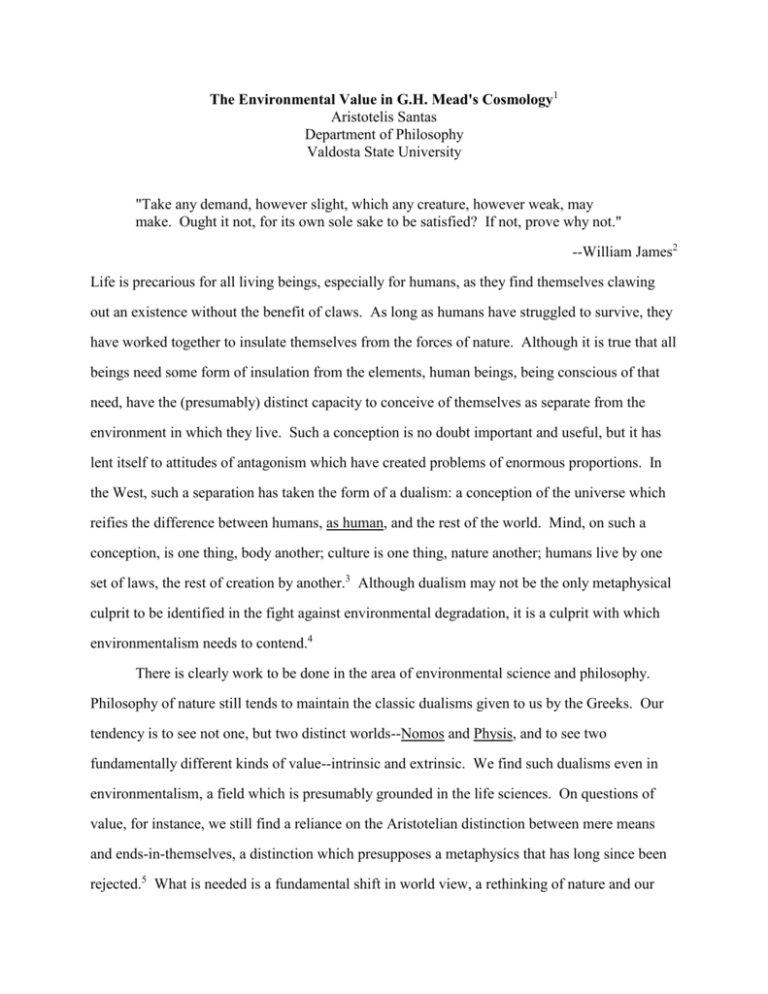
The Environmental Value in G.H. Mead's Cosmology1 Aristotelis Santas Department of Philosophy Valdosta State University "Take any demand, however slight, which any creature, however weak, may make. Ought it not, for its own sole sake to be satisfied? If not, prove why not." --William James2 Life is precarious for all living beings, especially for humans, as they find themselves clawing out an existence without the benefit of claws. As long as humans have struggled to survive, they have worked together to insulate themselves from the forces of nature. Although it is true that all beings need some form of insulation from the elements, human beings, being conscious of that need, have the (presumably) distinct capacity to conceive of themselves as separate from the environment in which they live. Such a conception is no doubt important and useful, but it has lent itself to attitudes of antagonism which have created problems of enormous proportions. In the West, such a separation has taken the form of a dualism: a conception of the universe which reifies the difference between humans, as human, and the rest of the world. Mind, on such a conception, is one thing, body another; culture is one thing, nature another; humans live by one set of laws, the rest of creation by another.3 Although dualism may not be the only metaphysical culprit to be identified in the fight against environmental degradation, it is a culprit with which environmentalism needs to contend.4 There is clearly work to be done in the area of environmental science and philosophy. Philosophy of nature still tends to maintain the classic dualisms given to us by the Greeks. Our tendency is to see not one, but two distinct worlds--Nomos and Physis, and to see two fundamentally different kinds of value--intrinsic and extrinsic. We find such dualisms even in environmentalism, a field which is presumably grounded in the life sciences. On questions of value, for instance, we still find a reliance on the Aristotelian distinction between mere means and ends-in-themselves, a distinction which presupposes a metaphysics that has long since been rejected.5 What is needed is a fundamental shift in world view, a rethinking of nature and our place therein. What we need, in short, is a philosophy of nature which is in step with the findings and teachings of modern science. The pragmatic philosophy of George Herbert Mead may seem to be an unlikely starting place for this fundamental shift in world-view. Mead was not an environmentalist, not even a proponent of animal rights.6 Largely forgotten as a philosopher, he is mostly associated with Sociology. Beyond his influence on the school of symbolic interactionism, he is remembered mostly as someone who is nearly impossible to read. Though his reputation as a speaker and teacher was one of brilliance, his writing leaves little trace of the dynamism he is reputed to have had.7 Nevertheless, there is a great wealth of truth and wisdom in Mead's work, not only in his Social Psychology, but in his Philosophy of Nature. From his analysis of the act of reflection, to his treatment of emergence, to his musings on Einsteinian Relativity, Mead shows a tremendous depth of understanding in both science and philosophy (which, to his mind, were the same thing). Like so many important thinkers, the beauty of Mead's ideas is under the surface, hidden beneath a tough layer of technical terminology. There are two aspects of Mead's philosophy of nature that are particularly useful for the present purposes: his conception of the connection between the various living beings, from amoebas to humans, on the one hand, and his analysis of the relation between organism and environment on the other. Together, these aspects of Mead's cosmology should help to break down the radical dualisms between man and nature, mind and body, subject and object, man and "beast." My focus in this work will be Mead's views on the relationships between humans, their environment, and the other organisms they share it with. It is my hope that out of an understanding of these relations will emerge two things. First, out of Mead's conception of nature will emerge a coherent account of the existence of environmental values, one which avoids the intrinsic/extrinsic dualism and makes ascriptions of environmental value scientifically evaluable. Second, Mead's philosophy can provide a general pragmatic framework for environmental ethics, one which would remove the existing tendency to hypostatize distinctions into ontological dualisms and replace it with an understanding of both the differences and continuities between these entities that make up our world. Mead's Cosmology In the essay entitled "Mechanical and Teleological Objects,"8 Mead outlines a continuum of existence which ranges from inanimate objects to unicellular organisms, then from unicellular to the multicellular organisms, and then to human beings. Purely mechanical objects, says Mead, are entirely determined by their environment. Having no goals or aims, no need or desire to be fulfilled, they simply react to some precedent action. A rock falls into the water and the water splashes. The relationship is a simple one of cause and effect. Similar is the case for the most simple forms of life. Unicellular organisms resemble mechanical objects in that they interact directly with their surroundings. As nutrients pass through permeable membranes they incorporate themselves into the living form. Yet these organizations of matter are at least partially teleological (i.e., goal directed) in that their matter is organized so as to perpetuate their existence. That is, they select their environment by taking in what they need and expelling what they don't. This feature of organisms is even more clear in higher forms of life. Multicellular organisms are clearly teleological. Not only do they select their environment to meet their needs, but their responses to the stimuli of their environment are indirect, i.e., they do not follow immediately from environmental stimuli but as a result of complex internal processes. In the case of the multicellular organism, there is no simple and direct passage of nutrients into the organism: they are neither acquired nor prepared for assimilation by the cells requiring nutrition. There is a higher level of organization which makes for a less direct relationship between the interior cells and the larger environment. Muscle cells in need of food, for instance, must communicate that need to the digestive system, which churns and gurgles and pangs so that a desire for consumption emerges. The resulting search for food, if successful, begins another process of digestion and assimilation, and so on. Such organization, for Mead, is a form of micro-society, though the constituent members have no consciousness of their activity.9 For all their complexity and sophistication, however, multicellular organisms still operate on a level of stimulus and response, since in the absence of self-consciousness, all activity is merely reactionary. There is a stimulus which calls out a response. The organism, ultimately, is reacting to the given stimulus. The human organism, by contrast, does not simply react to a given stimulus. For Mead, human beings have reached an even higher level of organization. Owing to their capacity for self-consciousness and meaning, they are capable of controlling their stimulus and hence controlling their environment. First, because humans are self-conscious, they are capable of conceiving themselves as something struggling to survive over and against other beings and external forces. They abstract the set of organized strivings that they are from the total set of interactions and strivings. We humans see ourselves, that is, as entities separate from our environment. It is for this reason that people can conceive of pests such as the ants in their yards as a 'them' to be exterminated. Had we no self-consciousness, we would only be able to respond to things on the occasions in which they stimulated us to act. Second, by virtue of this power of abstraction, humans are capable of assigning different meanings to the events in their perception. Depending on the meaning assigned, the response will vary.10 An ant mound may stimulate us to act in a variety of ways, depending on how we view it. My neighbor sees in ant mounds invaders of his property;11 ecologists see something quite different. As the perception varies, so does the response. To take another example, if a dish of food is placed before someone, and that someone, though hungry, knows that it is intended as a test of willpower, it's likely that he won't eat it; but if a hungry dog is given such a dish she will not search for a significance, a way of looking at it: she will only sniff for edibility before she eats. We may choose, Mead would argue, to respond to the "test stimulus" by attending to that character of the event, but dogs cannot. Notice that although humans can be distinguished from other life forms by virtue of this capacity for self-reflection, there are no grounds here for conceiving of humans as ontologically different from the rest of creation. Thinking, on this account, is not some metaphysical quality given to humans from on high; it is a natural product of evolution.12 Mind, according to Mead, is a form of consciousness emerging out of the peculiar conditions of the human environment.13 Whether the life form is human or protist, the relationship it holds with its environment is a dynamic one, having a much greater degree of complexity than we are apt to presume. In the essay "Form and Environment,"14 Mead explains that a living form, human or otherwise, must not be construed in complete abstraction from its environment. Although it is useful for many purposes to consider an organism as an entity distinct from the elements surrounding it, strictly speaking, no such distinction exists. First of all, there is always a flow of material in and out of the membranes of the organism as it reconstructs and replenishes itself with the stuff of the "outside world." In unicellular organisms such as amoebas, the flow is direct and easy to understand; in the multi-cellular the flow is less direct and correspondingly more difficult to keep in mind. Ants, cats, frogs and lizards all breathe in and out, eat and excrete. In so doing they recreate themselves and their environment. Moreover, what they create themselves out of is their environment and that with which they recreate their environment is themselves. Secondly, the organism is part of what constitutes its environment in the obvious sense that it is a member of an ecosystem. An ecosystem, after all, is but a series of relations between constituent members. An environment, accordingly, must include the living things which interact within it. Part of most people's environment (like it or not) is the ants in their yard, and vice versa. The ants, were they capable of self-consciousness, would be just as inclined to be rid of us as many of us are of them. Thirdly, an organism is part of its own environment insofar as its activities determine future states of those surroundings in which it acts, so that its present environment is a function of its past activities and its future is a function of the present. Every life form determines its environment in this way, though it is clear that larger and more complex beings often have greater determining power than their less complex counterparts. Aerobic bacteria take gas from the atmosphere; beavers build damns; humans clear forests and spray pesticides. All this is simply to say that organisms have an impact on their environment, and that impact has a role to play in the organism's future character. In this interactive process between living form and environment, the lines separating organism from environment blur into areas of interchange, of reciprocal adaptation and readaptation. Unlike the case of purely mechanical interaction (where one event simply determines the next), the interaction between organism and environment is one that is truly interactive, or, dynamic. It is here that one may draw the distinction between mechanism and life form--along the lines of the difference in their modes of interaction. The processes of the living, therefore, are irreducible to those of the non-living. It would be a mistake, however, to attribute to Mead a dualistic conception of living vs. non-living. For Mead, the living emerged out of the non-living, just as molecules emerged from atoms and conscious beings from the nonconscious.15 Although there are distinctions to be drawn between the various beings in the world, distinctions by themselves are not ontological chasms. Ironically, in the case of mechanical and teleological interaction, it is this very difference between the interactive modes of these objects which constitutes the blurring of the lines of separation between form and environment. Putting the various forms of life on a scale from the simple to the more complex, we find varying levels of both determining power and dynamism on the part of the organism. The greater the complexity and organization, the greater the determining power. In the case of human beings, the power has taken on frightening proportions. Mead remarks in Mind, Self and Society that what is striking about the human organism is the level of control that it commands over its environment. He writes: The human form establishes its own home where it wishes; builds cities; brings its water from great distances; establishes the vegetation which shall grow about it; determines the animals that will exist; gets into that struggle which is now going on with insect life, determining what insects will continue to live; is attempting to determine what microorganisms shall remain in its environment.16 Written in the early part of this century, this passage anticipates some of our current dilemmas. The fact that we have such control is a great part of our ecological problems, although it can be argued that our control is ultimately a false control, one that put us in a precariously fragile position on the planet. Mead can be criticized here for a certain amount of naivete, but his analysis shows great insight, nonetheless, into the purpose behind our conduct: we are, in the end, organisms seeking control. What appears today is that much of the control we have been taught to accept as necessary and good is illusory. Pragmatic Environmentalism Mead's philosophy of nature is not simply a descriptive environmental philosophy; it provides a framework for developing an environmental ethic by making room for a coherent conception of environmental values. Unlike traditional theories which construe values as either metaphysical properties of things (attached to them somehow by divine design) or as the mere preferences of the human animal, Mead's view conceives of values as functional properties which emerged along with the needs and wants of living things. In a brief moment of eloquence, Mead writes: "Even the scientifically tough-minded men must recognize that values have arisen in the universe as genuinely as molecules or galaxies or the tides of the seas."17 Values, for Mead, are intrinsic18 properties of things in the world. With the emergence of living things emerge functional needs; values are nothing more than potential or actual fulfillments of those needs. Grass, for instance, came to have the emergent property of value as soon as there were animals who used it for food. The dung of those animals, by the same token, came to have value insofar as it provided nutrition for plants. Value, on this view, is a triadic relation between organism, the thing it needs, and the specific function which that thing fulfills.19 Given such a conception, it is a mistake to relegate values to the realm of human subjectivity. Mead continues: "[Values] belong, to be sure, to the perspectives of human society, but there is no aspect of the universe that is not a perspective, and the tough-minded scientist is the last person who can deny that the human perspective belongs to the universe of science, for his toughness consists in denying any transcendence of man above his habitat." The subjectivity of value judgments, therefore, is no greater in principle than that of any other set of judgments. Like John Dewey,20 Mead believes that values can be postulated to exist and tested with the same methodological rigor as any other postulated qualities. There are further conclusions to be drawn from Mead's philosophy of nature, religious and ethical. A religious attitude, according to Mead, is the extension of the self beyond the ordinary boundaries of ethics the moral community. "[T]he attitude [of religion] has to be one that carries this particular extension of the social attitude to the universe at large."21 Getting people to adopt this attitude, of course, is no small task--having them to identify with large groups of human beings is difficult enough. Even Mead himself saw the consideration of nonhuman interests as going beyond the call of duty; yet effecting such an identification is not an insurmountable obstacle. There was a time when the "civilized" world saw the members of tribal societies (not to mention members of other races) as literally subhuman. These others were seen as radically other, their resemblance to ourselves being hidden by our ignorance and fear. Although there are remaining rags and remnants of this attitude, our basic world view no longer ignores the continuity between all human beings. The problem--perhaps the main problem--with which environmentalism has to deal is getting people to see the connections between themselves and the rest of the world. It is here, I think, that Mead's pragmatism is particularly useful. Focusing on the connectedness outlined in Mead's cosmology, one can create a basis for what Mead called a religious (and we should call an ethical) attitude towards our environment. A self-conscious feeling of connectedness, of being at home in the world--so long as it is tempered with a respect for the processes which comprise and sustain the home--has for a long time been seen as a condition of religiosity and the apogee of moral life. The time has come, perhaps, given the current state of the globe, to stop conceiving of such a feeling as supererogatory, and treat it as a subject of moral education.22 The ironic fact of our ecological crisis is that self-consciousness--the precondition for this feeling of connectedness--is precisely what makes it possible for us to perceive ourselves as radically distinct from our surroundings. Mead's model explains the irony: because we are selfconscious, we are capable of conceiving of ourselves as distinct beings; and as we develop this capacity of distinguishing, we run the risk of confusing our abstractions with ontological categories. Yet Mead also explains that the very capacity which makes us liable to this error is what makes the greatest understanding of our true place possible. Conscious activity is a higher level of connectedness. When the awareness of such connection is greatly heightened, a feeling of exhilaration ensues. We may even deem it a religious experience, though the connotations of this expression are too complex to introduce here. Suffice it to say that so far as a moral agent endeavors to find her true place in the nature of things, she is in need of cosmology; and inasmuch as environmental ethics concerns itself with seeking a place in a larger whole, Mead's cosmology, which emphasizes continuity between the various elements of the world, lends itself to the environmental point of view. Mead's cosmology is certainly not a panacea, but it gives us a pragmatic framework for effecting environmental reform. At the very least, his philosophy provides a foundation for a sorely needed shift in attitude. Notes 1. Published in A. Light and E. Katz, eds., Environmental Pragmatism (London: Routledge and Kegan Paul, 1995). An earlier version of this paper was delivered to the 1994 North American Interdisciplinary Wilderness Conference, Weber State University, Ogden, Utah. 2. From James, Essays in Pragmatism,2. Alburey Castell, ed. (New York: Hafner, 1948), p. 73. 3. See, for example, Lynn White's essay, "The Historical Roots of Our Ecologic Crisis," Science, Vol. 155, No. 3767 (March 1967), pp. 1203-1207, for a discussion of the role of dualism in environmental degradation. 4. Reductionism (which arguably is a child of dualism) can also lead to environmental recklessness. Just as one may be abusive to those with whom one shares no commonality, she can also rationalize degradation of another by claiming the other to be merely a part of his or her self--to be used in whatever way is seen fit. Complete identification can be just as problematic as complete isolation. Reductionism, which lends itself to identification, can be as much a source of rationalized selfishness as dualism. (I say 'lends itself' because there is no necessary connection between reductionism and identification, any more than there is an infallible link between ontological dualisms and environmental degradation. Nevertheless, there are points of view which make the rationalizations flow more freely. Both dualism and reductionism, to my mind, encourage the sort of simple-mindedness to which foolish persons continually submit.) 5. Aristotle's distinction between intrinsic and extrinsic goods can be found in the Nicomachean Ethics, Bk. I. Keeping in mind that he identified 'The Good' with 'that towards which all things aim,' we can see the connection of the doctrine of ends-in-themselves (for him the same as intrinsic goods) to that of final causes and his teleological metaphysics. Dewey traces this connection in Chapter III of Reconstruction in Philosophy (Boston: Beacon, 1948), and in the chapter of Human Nature and Conduct (New York: Henry Holt, 1922) entitled "The Nature of Aims." 6. Mead writes: "We put personalities into animals, but they do not belong to them; and ultimately we realize that those animals have no rights. We are at liberty to cut off their lives; there is no wrong committed when an animal's life is taken away." His reasoning is that since they have no self-consciousness, they have neither a past nor a future to be taken away. "They have not that future and past which gives them, so to speak, any rights as such." Mind, Self and Society, Charles Morris, ed. (Chicago: Univ. of Chicago, 1934), (hereafter, MSS) p. 183. Mead is following Kant's moral rationalism here, which makes reason the fundamental moral criterion. Had he followed Bentham, Mill, and James and adopted sentience as his criterion instead, his cosmology might easily have led him to a different position on the moral status of non-human animals. For James' discussion of sentience and obligation, see his essay "The Moral Philosopher and the Moral Life," in William James, Essays in Pragmatism, pp. 65-87. 7. I am reminded of a story of an aspiring graduate student proposing to his major professor that he translate Mead's Mind, Self and Society into French, only to evoke the response "Hadn't you ought to first translate into English?!" 8. G.H. Mead, Philosophy of the Act, Charles Morris, ed. (Chicago: Univ. of Chicago, 1938) (hereafter, PA), Essay XVII, pp. 301-7. 9. Such a conception is implicit in his discussion of want in the essay "Mechanical and Teleological Objects," in PA, pp. 301-7. See esp. pp. 304-5. Compare this to his discussion of human versus insect societies. (He argues that the main difference is that insect societies differentiate roles on a physiological basis, making its members more like physiological parts of an organism than individual members of a group.) See MSS, pp. 227-237. It also works the other way around: a society is a highly developed form of organism. When a society reaches conscious organization, there emerges a fifth dimension in the universe--the institution. 10. See MSS, Part II, esp. pp. 117-125. 11. My neighbor informs me almost daily as he spreads poison on the fire ant mounds in his yard that there is absolutely nothing valuable about ants. Our government, moreover, is cheating us, he says, by not allowing us to use stronger chemicals to get rid of them. As certain as I am that the global ecosystem could not survive without ants, I am even more certain that telling him so would have no effect on his convictions. Unfortunately, he is not alone in his views. 12. Mind, however, is not reducible to merely mechanical phenomena. In explaining his behavioristic point of view, Mead sharply criticizes Watson's reductionist behaviorism for failing to take note of the fact that thinking and all that it entails--attitudes, language, significance--exists as a dynamic functionality which cannot be explained away in mechanistic terms. See MSS, Part I, for a criticism of reductionist behaviorism. 13. See MSS, Part II. 14. Mead, PA, Essay XVIII, pp. 308-12. 15. For a concise discussion of emergence, see PA, pp. 640-3. 16. Mead, MSS pp. 249-50. 17. Mead, PA, p.495. 18. The word 'intrinsic' may bring to mind the sort of metaphysics Dewey and Mead were trying to dismantle, but it should not. Dewey, who spent most of his career criticizing the doctrine of ends-in-themselves, did not argue against intrinsic value per se. All he meant by intrinsic value was something one prizes for its own sake. Traditional metaphysics offered a "grounding" for Intrinsic Value, while Dewey offered a means of evaluating an act of prizing by appeal to the means required to bring them about. (See his "Theory of Valuation," in International Encyclopedia of Unified Science (Chicago: Univ. of Chicago, 1939). vol. II, no. IV, esp. Secs. V and VI.) Intrinsic value for Dewey was no more absolute than instrumental value was "merely relative." Part of the point of Art As Experience (New York: Perigee, 1934), after all, was to show that we need to see the instrumental nature of intrinsic value and vice versa. What Mead's philosophy adds to Dewey's conception of value is the idea that all values are intrinsic to (i.e., inseparable from) some functional system. 19. Mead never speaks of value as a triadic relation, but following C. S. Peirce, he identifies meaning as such. A sign, according to both Mead and Peirce, is a triadic relation between the signifier, the interpreter, and the thing signified. A significant symbol, that is, means something to someone. For Mead's specific version of this general pragmatic conception of meaning, see MSS, pp. 75-82. For Peirce's discussion, see "The Peirce/Welby Correspondence," in C. Hardwick, ed., Semiotic and Significs, Oct. 12, 1904, pp. 22-36. See also "Logic as Semiotic: The Theory of Signs," in Justus Buchler, ed. Philosophical Writings of Peirce (New York: Dover, 1955), pp. 98-119. 20. For Dewey's discussion, see "Theory of Valuation." 21. Mead, MSS, p. 275. See also p. 289. 22. I shudder to think of the totalitarian sound of this sentence and anticipate the label 'environmental fascism.' I do not intend here a program of rigorous inculcation, pledges of allegiance to Mother Nature and rote repetition of some environmental creed. Besides being overly intrusive on individuality, such measures wouldn't work. What I have in mind is the sort of educational environment espoused by Dewey in Democracy and Education (New York: Macmillan, 1916). The whole point of education, for him, was to get the pupil to see and understand her connection to the world in which she lives. There is no reason why the study of our "natural" environment should not be part of that process.
